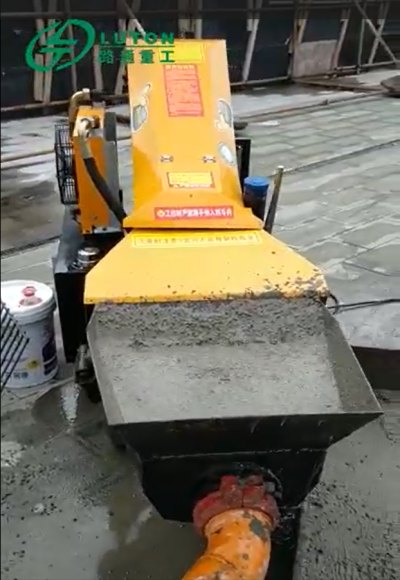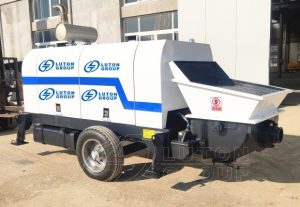Secondary construction pump, also known as secondary structural fine aggregate concrete grouting pump, or secondary construction column pump, is a new type of multifunctional construction machinery. It has a wide range of usage, particularly in the transportation of fine stone concrete in building groups, the secondary pouring of columns in narrow building floors and other construction scenarios.
The device has a compact structure, simple operation, small volume, light weight as well as convenient movement. It improves the construction efficiency obviously. The hydraulic system with electromagnetic control and PLC controller, ensure stable performance, low failure rate, and long service life. All those greatly improve production efficiency, save manpower and reduce construction period.

| Model | LT-8A Oblique Pump |
| Max. Theo.Concrete Output. | 8-10 m3/h |
| The Biggest Transportation (Vertical/Horizontal) | 30m/80-100m |
| Diameter of Delivering Pipe | 80mm |
| Max. Aggregate Diameter | 30mm |
| Rate Power of Diesel Engine | 25HP |
| Dimensions: length×width×height | 2500*1000*1500 mm |
| Total Weight | 780Kg |
What Is Secondary Construction Pump Used For
The main use of secondary construction pumps includes:
- Transportation of mortar and fine aggregate concrete in high-rise buildings
- Filling of secondary construction columns,
- Various pressure grouting in reservoirs, hydropower stations, ports and docks
- Foundation treatment, reinforcement weak foundation and Grouting
- Backfilling grouting and anchor rod support in tunnel, subway and mining construction, etc.
However, the use of secondary construction pumps is not just limited in all the five aspects.
It can effectively solve the difficult pouring problem of the structural colums with small-top and dry-bottom beam. In addition, secondary construction pumps can work in some special construction environments, such as railway and highway tunnels, diversion tunnels, culverts, mining tunnels, bridge tunnels and other tunnel bodies. They can also handle projects in water conservancy engineering, hydropower engineering, slope support, underground construction operations, foundation filling engineering and pouring of structural columns in large building groups.




Overall, secondary construction pumps play an important role in the construction industry due to their high efficiency, stability, and portability, providing efficient and reliable solutions for various construction tasks.
What Are The Types Of Secondary Construction Pumps
There are several types of secondary construction pump, diesel or electric, oblique or horizontal for all kinds of construction projects.
Oblique Secondary Construction Pump
This is an important type of secondary construction pump. The main specifications of LUTON inclined pump include 5.5kw, 7.5kw, 11kw, 15kw, etc. Among them, the 15kw inclined pump are the hot saled models. There are two power source optional, diesel and electric.

Small In Size
High-level Configuration
Compact Structure
Lightweight
Stable Performance
Long Service Life
| Transport Capcity | 6-8m3/h |
| Pumping Distance ( vertical ) | 10-20m |
| Delivery Distance ( horizontal ) | 40-80m |
| Allowed Particle Size | 100-300mm |
| Motor Power | 15kw |
| Pipe Diameter | 100mm/80mm |
| Overall Dimension | 1800*700*1200mm |
Horizontal Secondary Construction Pump
A horizontal pump is another common secondary construction pump. According to the different power, horizontal pumps can be divided into multiple types such as 7.5kw, 15kw, etc. They can be divided into ordinary manual walking and electric chassis walking according to their walking methods, as well as mixing and non mixing types based on whether they have mixing blades. In addition, the horizontal pump is equipped with an accumulator, which plays a great role in preventing pipe blockage. Especially for 30kw and 37kw horizontal pumps, they can pour flooring and have a wider range of applications.

Fully Mechanized Operation
Good Pouring Continuity
Save Labor Costs
Small Size & Simple Operation
High Conveying Efficiency
Reliable Quality
| Conveying Distance ( vertical ) | 20m |
| Operation Mode | Remote Wireless or manual |
| Delivery Distance ( horizontal ) | 60m |
| Efficiency | 6-8m3/h |
| Allowed Particle Size | <20mm |
| Pipe Diameter | 80mm |
| Motor Power | 15kw |
| Overall Dimension | 1600*650*1100mm |
In all, each secondary pump has its unique characteristics and applicable scenarios, and the selection needs to be determined based on specific engineering requirements and construction environment. At the same time, in order to ensure the safety and efficiency of construction, it is necessary to strictly follow the operating specifications and regularly maintain and upkeep these pumps when using them.
What Differences Between Secondary Construction Pumps And Spraying Pumps
There are significant differences between secondary construction pumps and spray pumps in multiple aspects.

Firstly, from the perspective of function and application scope, secondary construction pumps are mainly used for the construction of building floor structural columns, such as indoor secondary structure pouring columns, lintels, ring beams, partition walls and other engineering projects. It is suitable for construction in narrow spaces and can effectively solve the difficulties in the pouring process of structural columns. The spray pump is mainly used for spraying liquid coatings, such as PU coatings, UV coatings, paints, resin, chemicals, etc. It is widely used in furniture factory spray painting, chemical liquid transportation, and automatic spray machine matching oil supply systems.
Secondly, from the perspective of working principle, the secondary construction pump mainly relies on full hydraulic system control, using a hydraulic piston pumping structure to transport concrete or mortar to the construction site. The spray pump, on the other hand, extracts the coating from the container and sprays it onto the surface to be coated by compressing air or liquid pressure.
In addition, there are differences in design and structure between the two. Secondary construction pumps can be designed to meet the needs of different construction scenarios, including vertical, horizontal, and inclined types. The spray pump mainly focuses on the supply of paint, pressurization, and spraying process.
In all, there are significant differences between secondary construction pumps and spray pumps in terms of function, application scope, working principle, and design structure. When choosing which equipment to use, decisions need to be made based on specific construction needs and environment.
Besides, there are also other small-scale or large-sized concrete pumps, as well as pumps with mixer machine from LUTON GROUP for all different construction requirements. LUTON CONCRETE PUMPS provide you all kinds of ideal construction machienry.
Summary
As a type of equipment designed specifically for construction, secondary construction pumps display numerous outstanding performance characteristics.
Secondary construction pumps play an important role in construction due to their high efficiency, stability, strong adaptability, easy operation, and low failure rate, providing strong support for various engineering projects.
With various advantages, secondary construction pumps are mainly used in construction scenarios such as conveying fine aggregate concrete for floor groups and pouring secondary structural columns, in high-rise buildings, reservoirs, hydropower stations, ports, tunnels, subway mining construction and other fields, providing efficient and reliable solutions for various projects.
Hot Sales Of LUTON Concrete Pumps

Mini Concrete Pump

High-Pressure Concrete Pump

Concrete Trailer Pump

Concrete Mixer Pump

Concrete Boom Pump


